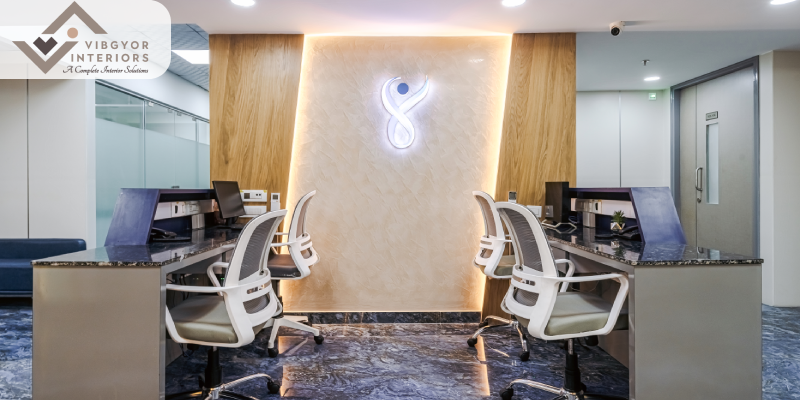When planning a modern hospital interior design, several fundamental principles must be considered to create a space that supports both patients and healthcare professionals. A well-designed hospital interior goes beyond aesthetics it ensures comfort, safety, accessibility, and efficiency. By incorporating thoughtful design elements, hospitals can create a healing environment that improves patient outcomes and enhances staff productivity.

Contents:
- Patient-centered design for a healing environment
- Functionality and space optimization
- Accessibility and inclusivity
- Safety and hygiene standards
- Integration of advanced technology
- Noise control for a peaceful environment
- Staff comfort and efficiency
- Conclusion
Here are the various concepts in hospital interior design:
1. Patient-Centered Design for a Healing Environment
A hospital interior design should prioritize patient comfort and well-being. A calming atmosphere can be achieved through the use of soft, soothing colors like blues and greens, which help reduce stress and anxiety. Natural lighting plays a crucial role in enhancing mood and aiding recovery, while proper ventilation ensures fresh air circulation, contributing to a healthier environment. Every element, from furniture placement to decor choices, should foster a sense of tranquility and reassurance for patients and visitors.
2. Functionality and Space Optimization
Efficiency is a cornerstone of modern hospital interior design. Every space, from patient rooms to hallways and waiting areas, should be designed with a clear purpose. Patient rooms must be spacious enough to accommodate medical equipment while maintaining a comfortable setting for patients and caregivers. Additionally, an intuitive and well-structured layout ensures seamless movement between departments, minimizing confusion and delays. Wide corridors, accessible pathways, and well-marked signage contribute to a smooth workflow, enhancing the hospital’s operational efficiency.
3. Accessibility and Inclusivity
A well-designed hospital must be accessible to all individuals, including those with disabilities. Features like wide doorways, ramps, accessible bathrooms, and easy-to-read signage are essential in promoting inclusivity. Properly designed pathways ensure that wheelchairs and hospital beds can be maneuvered effortlessly, providing convenience for both patients and medical staff. By prioritizing accessibility, hospitals can cater to the needs of diverse individuals and enhance the overall patient experience.
4. Safety and Hygiene Standards
Safety is paramount in hospital interior design, as medical environments must be free from potential hazards. To prevent accidents, non-slip flooring should be installed, and furniture should have rounded corners to minimize injury risks. Adequate lighting is essential in reducing falls, particularly in patient rooms, hallways, and staircases. Furthermore, hygiene is a top priority in hospital settings, necessitating the use of durable, easy-to-clean materials that can withstand frequent sanitation procedures. Proper waste management systems and antimicrobial surfaces further enhance infection control.
5. Integration of Advanced Technology
Incorporating modern technology is essential in modern hospital interior design to enhance medical care and streamline operations. Hospitals rely heavily on digital tools, smart medical equipment, and automated systems to improve patient monitoring and treatment. A well-planned interior should accommodate these advancements while maintaining a clean, organized aesthetic. Technology-friendly spaces ensure that medical devices, digital displays, and electronic health record systems function seamlessly without disrupting the hospital’s overall design.
6. Noise Control for a Peaceful Environment
A quiet environment plays a crucial role in patient recovery. Excessive noise can lead to stress, discomfort, and disrupted sleep patterns, affecting both patients and staff. To address this, hospitals should incorporate soundproofing materials, such as acoustic panels and soft furnishings, to minimize noise levels. Design elements like thick curtains, carpeting in waiting areas, and enclosed nurse stations can further contribute to a more peaceful atmosphere, promoting relaxation and faster recovery for patients.
7. Staff Comfort and Efficiency
While patient care is the primary focus, the well-being of hospital staff is equally important. Medical professionals work long and demanding hours, making it essential to design practical and comfortable spaces for them to recharge. Break rooms, ergonomic workstations, and well-equipped nurse stations contribute to staff efficiency and job satisfaction. By providing designated rest areas, hospitals can help reduce stress and improve overall staff performance, ensuring that they deliver the best care possible.
A well-executed modern hospital interior design seamlessly integrates aesthetics, functionality, and technology to create a healing environment. From patient-centered spaces to efficient layouts, safety measures, and staff well-being considerations, each element plays a crucial role in shaping the hospital experience. By prioritizing accessibility, hygiene, noise control, and advanced technology, hospitals can provide superior care while fostering an atmosphere of comfort and efficiency for both patients and healthcare professionals.
